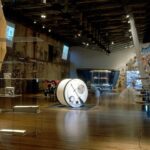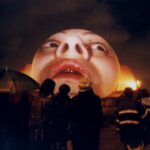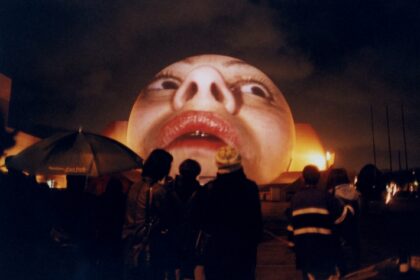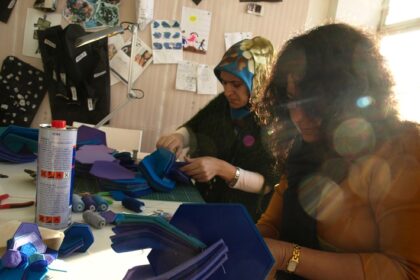A Week in Pasadena: Collaborations Toward a Design Modality For Ethnographic Research
Luke Cantarella, Christine Hegel and George E. Marcus
This article describes a recent phase of an ongoing collaboration that has evolved since 2001 between anthropologists George Marcus and Christine Hegel and designer Luke Cantarella. The collaboration has been driven by the observation that the signature method of anthropological research—ethnographic observation and immersion in fieldwork—can benefit from some of the techniques and interventions that are characteristic of studio design inquiry and participatory art practice. It has also been propelled by our observation of the ways in which design or art commissions can evolve into ethnographic inquiries. Marcus founded the Center for Ethnography at the University of California, Irvine in 2006, and he has since discovered that a number of new labs, collaboratories, or studios have emerged over the past decade or more to experiment with the classic orientations of ethnographic method, leaning especially toward design and art practices, combined with new visual and sensory technologies. In 2010, he met Cantarella when he was head of the Scenic Design faculty at UCI, and Hegel when she was an associate of the Anthropology Department at UCI. Cantarella and Hegel produced an initial project together at UCI that led to further, ongoing collaborations, including the Stern v. Marshall Archive (SVMA) project described below. An examination of this project provides an opportunity to articulate, in the midst of the creative process, the first draft of a working model of our activity together, which we are calling Productive Encounters. We would like to thank Elizabeth Chin, her graduate student participants in the Laboratory of Speculative Ethnology, and others at the Art Center College of Design who provided resources, skills and insights, as well as Justin Richland and Kent Richland for their willingness to collaborate in the workshop and for sharing material for design/ethnography experimentation.
Monday: Into the Wind Tunnel
A series of massive arched wooden trusses spanning the distant ceiling are among the first things one notices upon entering the Wind Tunnel, a cavernous hall on the south campus of Pasadena’s Art Center College of Design (ACCD). It’s an impressive white and grey space as big as a football field, and containing numerous reconfigurable studio spaces, a model-making workshop, a small electronics fabrication lab, massive cutting tables, large format printers and three self-contained rooms marooned in the space like icebergs in the open ocean. Originally built by a consortium of leading aerospace manufacturers at the end of World War II, it now houses the innovative Media Design Practices (MDP) program, an M.F.A. program that trains students to address social issues through design practice. It was here we came in the summer of 2014 to workshop an ethnographic project as guests of Elizabeth Chin, an anthropologist and co-director of the “Field” track of MDP, who was running a Laboratory of Speculative Ethnology focused on articulating “a synergy between ethnography and design that affirmatively claims space beyond normative, white territories.”
While Chin’s program uses ethnographic processes to enrich and problematize design practice, we hoped to bring design practices to bear in the framing of an emergent ethnographic project. In the fall of 2013 the three of us (Cantarella, Hegel and Marcus) had a series of conversations with legal anthropologist Justin B. Richland. As a result of these conversations Richland proposed a collaboration with us to explore a new working methodology focused on the famous Stern v. Marshall legal case, in which Anna Nicole Smith, and later her estate, sued her deceased husband’s son for excluding her from his father’s estate. Richland was very closely acquainted with the case because his father had represented Anna Nicole Smith. The goal was to formulate new research questions in the interdisciplinary space between anthropology and legal studies, using design studio practices as a key methodology. We planned to spend a week together in the ACCD lab working towards the design of a Productive Encounter (see below) to be staged at a later date.
As a socio-legal project, the history of the Stern v. Marshall case, its procedures, arguments and ramifications presented a fascinating subject that might be read successfully through the normative, highly textual process of legal anthropology. However Richland was certain that the fabulous, both in the sense of extraordinary and mythological, quality of the narrative surrounding the case was seeping into the process of legal reasoning. Evidence for this seepage was easy to spot, for instance, in Chief Justice John Roberts’ 2010 announcement of the Supreme Court’s Stern v. Marshall decision in which he alluded to Charles Dickens’ Bleak House, reaching far beyond the procedural history of the case. As Richland pointed out, this literary reference was contrary to the only legally relevant way to describe the manner by which a case arrives at the Supreme Court; its procedural history. So how to understand (and investigate) the nature of this particular interface between law and narrative? How to tell a coherent yet authentic story about this phenomenon, which was burdened by an over-determined narrative and mired in such a dense, well-financed legal morass? This, we judged, was an ideal test case for our interest in aligning ethnographic analysis with research protocols associated with studio design exercises.
The workshopping of Richland’s project at Elizabeth Chin’s ACCD studio in the summer of 2014 presented us with an opportunity to reflect on the nature of the collaboration that we had begun in earnest three years earlier and which had already been developed into two fully realized projects. The first of was 214 Sq. Ft., a full-size recreation of an Orange County motel room commissioned by Project Hope Alliance to raise awareness about homelessness, and the second was Trade is Sublime, an installation piece comprised of a trio of short films exhibited at the World Trade Organization in Geneva, Switzerland. These projects trafficked in the territory between design and ethnographic practice, guided largely by the mutual experience of our team; Cantarella, a scenic design practitioner mainly for theater, Hegel, an anthropologist with a background in theater, and Marcus, an anthropologist who has written extensively on methodological concerns.[1] Although these three projects differ considerably in site, subject and medium, they share commonalities at the intersection between design and ethnography that we are interested in examining more closely.

Chin’s Laboratory of Speculative Ethnology, which was strewn with the tangible materials of her current project (sewing machines, Arduino processors, GoPro cameras, yards of Dutch-wax textiles from east Africa, and a profusion of post-it notes), was in many ways a familiar environment for us. Like a theatrical scene or costume shop, it evinced the messy and rich process of refining ideas and the material manifestations of a studio-based design practice. At the same time, we sensed that the modalities of design practice and the research and analysis processes that they employ to might not immediately be legible in relation to our new ethnographic investigation for the Stern v. Marshall Archive (SVMA). We use the term SVMA to refer to the large collection of texts and materials related to the phenomena of Stern v Marshall that Justin Richland had accumulated while researching the case. We needed to articulate more concretely our process for layering design modalities into ethnography in order to work effectively with a new collaborator. Making our process legible to Richland would help organize our schedule and needs in the week to come; at the same time, a generalizable description of our working process might be a useful guide for others wishing to employ these same tools. Specifically, we were interested in explicating some of our tacit assumptions about what was happening in the projects we had created and in beginning to construct a critical framework for assessing the value and operation of what we describe as a Productive Encounter.
Our proposition for design-influenced inquiry in anthropology envisions quite different ethnographic modalities than are currently in use.[2] Although ethnography has certainly evolved since Malinowski and ethnographers now deploy a wide variety of technologies, collaborate with subjects, use various representational strategies, and undertake multi-sited research, among other developments, most of these innovations are layered onto the same operating principles that have animated ethnography from the outset. Good ethnography is associated with being there/inside and with direct contact/first-hand experience, combined with duration to enhance validity. These two key aspects allow the ethnographer, so it goes, to hear and see what the non-ethnographer does not, and even what the ‘local’ does not because of the tacit nature of her knowledge. Although it is acknowledged to varying degrees that reality is co-constructed by an ethnographer and her subjects, we continue to position ourselves as observers tasked with the thick description of events unfolding around us, and the analysis of the knowledge and structural relations that they express.
Conversely, implementing design-based practices within the ethnographic endeavor offers a useful corrective to some of the inherent challenges to contemporary ethnographic research, such as the question of how to make “experts” the objects of study.[3] These practices make accessible aspects of fieldwork-in-process and open them to collective, collaborative assessment and reception by promoting the materialization of ideas and concepts into speculative design interventions. Traditional ethnographic research tends to be immersive and individualistic in nature. Design interventions, real or proposed, created alternate ways of “seeing” ethnography, beyond the reflexive reporting of ethnographic writing genres. In what follows, we describe a schema for workshopping such an intervention and elucidate it by exploring its application to the Stern v. Marshall Archive.
Tuesday: The Schema for a Productive Encounter

The figure above lays out a simple schema for understanding the relations of differing aspects of design and ethnographic practice that produce a Productive Encounter. The Productive Encounter is an exchange, dialogue, performance, interface or process that generates workable solutions to problems that emerge in pursuing ethnographic research on difficult objects of study, such as Richland’s interest in opening up already constituted legal knowledge to new interpretations through an investigation of the Stern v. Marshall case. While this encounter may manifest itself in a plethora of differing forms borrowed from art, design, theater, dance and social science practice and be used to investigate a variety of themes, subjects, and sites (both construed as traditional “field” sites or as networked systems), the central object of the work is always the encounter itself and its potential as a space of knowledge production. In the same manner that Big Data analysis allows large, complex quantitative data sets to be easily read, the Productive Encounter provides the same sort of generalizable approach to qualitative data. This approach allows us to shift from a reliance on the subtle technical skill set of observational ethnography to a reliance on the potency of designed encounters that make explicit or amplify tacit knowledge. While this tacit knowledge may often take the form of “raw” ethnographic data, as SVMA will show, workshopping a Productive Encounter may directly generate or influence higher-level analysis as well, such as suggesting new metaphors, theories or analytical frameworks.
We define the Productive Encounter through the relationship of three constituent elements: the necessary subject (theme, text, anthropological question), the interpretative community (ad hoc interpreters, self-defined community, network of experts, ourselves, etc.) and the design interface (object/artifact, space, process, game, etc.). The central design problem is how to articulate and combine these elements in order to maximize productivity. An important (but subsequent) corollary to the encounter itself involves the documentation of the knowledge that it produces and the generation of an analytic product (text or artifact) as a means to disseminate that knowledge. As we will explore in more detail below, the schema of the Productive Encounter hopes to re-center the ethnographic process on the encounter itself as a site of primary value—positioning any analytic work (resulting in writing for conventional publication genres) as often necessary but a secondary result. While the form and operation of Productive Encounters may mimic traditional artistic exchanges (as seen in galleries, theaters, etc.), we contend that their value lies in their power to reveal specific knowledge about social phenomena.
For the sake of clarity, we will expand on the schema through example. The following is a brief examination of how these elements came together and functioned in our 2013 project Trade is Sublime, which was developed as a scenographic proposition for ethnographic research at the World Trade Organization (WTO). Marcus’s ethnographic work at the WTO began in 2008 as part of a multi-investigator study led by Marc Abélès by invitation from then Director-General Pascal Lamy and funded by a sizeable French National Center for Scientific Research (CNRS) grant.[4] Despite Lamy’s support and the efforts of numerous ethnographers granted access to the Centre William Rappard (CWR) to observe institutional practices, interview members of the secretariat, and access bureaucratic artifacts, the organization proved frustratingly opaque. Normal ethnographic methodologies (long-term observation, interviews, etc.) largely failed to penetrate the professional culture of discretion that suppressed forthright reflection by the staff and delegates on the complexities of how the organization actually functioned.
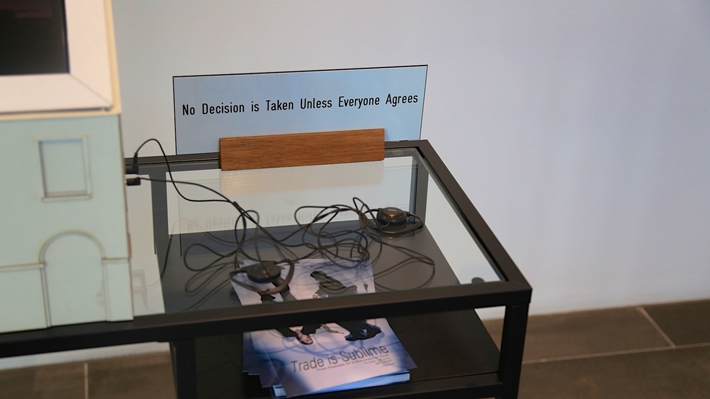
The informants’ careful presentation of productive continuity lay in stark contrast to the institutional crisis that was unfolding at the WTO during the slow failure of the Doha Round, a set of trade negotiations undertaken in 2001 and increasingly unlikely to be ratified by the member states. The failure of Doha potentially signified the end of the organization’s ability to approve large, multilateral trade agreements, radically changing the nature of its geopolitical role from central arbiter of global capitalism to marginal player. Marcus sought a return to the site with a “second-act” project that could generate new and potentially richer ethnographic data about this inscrutable site. With this aim in mind, Marcus invited designers and artists, including collaborators Cantarella and Hegel, to propose ideas for what was framed at the time as an intervention or art piece that would engage those in the organization and in turn illuminate its tacit or hidden facets.[5] For this project, we began with a clearly-defined interpretative community—the missions and member-state delegates, and the secretariat and staff of the WTO based at the Centre William Rappard (CWR), a massive government building built in the style of a Florentine villa on the shores of Lake Geneva. This community maps well on to the traditional anthropological notion of a “field site.” It is defined by a specific geographic locale and, despite its vastly heterogeneous membership representing the 160 member states of the organization and international Secretariat and staff, it can be said to exhibit a coherent cultural system.
The necessary subject for this project was developed in part through the process of design speculation. The initial field research brought forward a number of themes around which to organize the research, including questions about transparency, translation, the problematic of national histories and aims within the framework of global governance, and the question of whether the WTO model for multilateral trade has future relevance. As such, there were multiple possibilities for a necessary subject on which to focus. Moreover, the process of brainstorming, prototyping, and refining the design interface functioned not only as a way to articulate a future encounter, but also served as an interim analytic process. Working in a design modality, through which one seeks to materialize ideas or values, maximizes the use of lateral reasoning and reveals unexpected ethnographic insights that often remain hidden when pursuing step-by-step logic-based processes. After positing numerous design ideas that related to our various research questions we arrived at a confluence of design interface and subject that held the most productive possibilities.
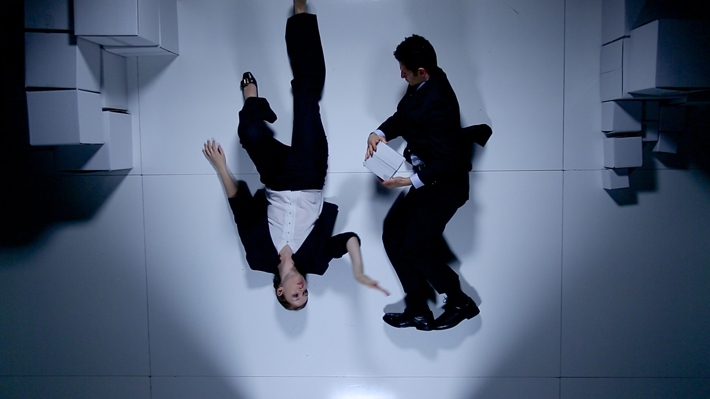
Our final design interface for Trade is Sublime was a triptych of short improvisationally-created films framed as ‘proposals’ for monumentalizing the WTO as a trade regime.[6] Each film explored one facet of the broader WTO institutional mandate to promote multilateral trade, namely: “Allow trade to flow more freely,” “Everyone must follow the same rules,” and “No decision is taken unless everyone agrees.” These films were displayed on screens embedded within scale models of the CWR, which houses the WTO, and exhibited in a heavily trafficked passageway at the CWR. This design interface raised a number of questions that the team wanted to explore in more depth, including 1) what did the renewed (since 2012) institutional commitment to architecture and art at the CWR, and concomitant decisions regarding the renovation of the building and the selection of art for purchase and restoration, reveal about concerns within the Secretariat regarding public perceptions of the institution? 2) if the Secretariat was in fact seeking to monumentalize the institution through these efforts, what aspect of its institutional mandate might emerge as central in the process of self-monumentalization?, and 3) what did members of the Secretariat envision as the future of the institution, despite the failure of the Doha round and uncertain international support?
In sum, the schema applied to Trade is Sublime would read as shown in the figure below.
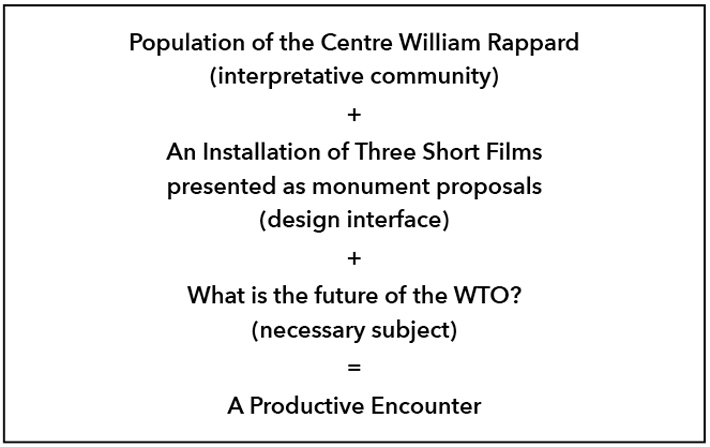
Designing, or staging, an encounter at the WTO served to catalyze new exchanges between the anthropologists and their interlocutors in the field site, and provided a useful technique for surmounting a typical ethnographic challenge: getting at tacit or exclusive knowledge. Trade is Sublime provoked a re-engagement with members of the Secretariat at the Centre William Rappard after a long absence by the researchers (Marcus and Jae Chung) and took up questions being posed by the institution itself in a non-literal form to stimulate interpretive practices. Although it would be useful to develop a more thorough definition for the qualities of productivity embodied in the WTO Productive Encounter, for now we can suggest a simpler metric for understanding its value. Trade is Sublime was a designed encounter that provoked or revealed alignments between anthropologists and their interlocutors, and generated new anthropological insights.
Wednesday: Designing a Productive Encounter as a Workshop Strategy
We’ll now consider the ways in which the Productive Encounter model outlined in Trade is Sublime was further developed in the SVMA project. After Hegel and Cantarella articulated an initial schema in preparation for the workshop, Richland arrived at the Wind Tunnel for an introductory day of conversation about how the Productive Encounter process could be brought to bear on his emergent project. The goal of the workshop was to use a process of design speculation to identify potential interpretative communities for the SVMA as a set of events, imaginaries, and discourses (beyond those individuals who seemed most obvious to Richland, such as those who played a direct role in the SVMA cases, fellow legal anthropologists, and lawyers and law scholars), and also to identify potential design interfaces that could interpolate alternate interpreters, clarify his questions, and reveal what was difficult to see as yet in the existing data. Hence, our first day of discussion entailed assessing the particular conditions of Richland’s project that contributed to his decision to bring design modalities into his working process, and responding to these conditions by developing a work plan for the following days that would make use of the particular resources (equipment, tools, materials, and design students) available to us in the lab.
The Conditions of the Project
It quickly became clear that Richland’s research on the Stern v. Marshall presented a unique set of challenges for this ethnographic modality. Among these were temporal conditions that required re-thinking what kind of groundwork was necessary for a Productive Encounter. Unlike Trade is Sublime in which the design intervention occurred subsequent to an initial period of ethnographic inquiry or 214 Sq. Ft., in which the material object became a site that generated ethnographic data, Richland’s project was emergent. Richland was fascinated by, and sought to resist, the popular narrative of a gold-digging beauty staking a claim to old money by manipulating the legal system, and a powerful family resisting these efforts through the use of power brokering. By beginning to identify a certain nexus of interrelated events that corresponded to primary sites in the world (the Supreme Court, Marshall’s Texas estate, the television media, etc.), he anticipated that this case might be fruitful for examining the intersection of inheritance and wealth, bankruptcy law, and popular culture. Therefore, our collaboration began before much data, beyond some primary texts and interactions (media clips, legal briefs, initial conversations with key players) had been collected. The nascent quality of the project and its complexity made it ripe for a workshopping, which would clarify the direction and scope of the project and make more visible the frameworks of understanding that grounded Richland’s suppositions.
Moreover, this was a second major research project for Richland and a topical departure from his previous work, which focused on the discursive production of tradition in Hopi courts.[7] The Stern v. Marshall project focused on a new legal setting (U.S. non-native courts) and some similar issues (inheritance) but also new socio-legal questions (bankruptcy, political influence on court proceedings, the media’s impact on legal reasoning, etc.). Added to these conditions was the fact that the socio-legal phenomena under investigation were primarily historical, so that many of the events had already occurred and would need to be examined post-facto. It was unclear what ‘new’ data could or should be collected, beyond interviews with those involved in the cases. Moreover, Richland’s father had represented Anna Nicole Smith’s estate (identified as “Stern,” her lawyer) twice at the Supreme Court. As a result Richland had been deeply involved with the case, knew the parties and the particulars of the cases extremely well, and over the years Richland and his father had discussed the peculiarities and broader implications of the cases.
Ethnographers often begin research by integrating themselves into a community, building relationships and trust in order to avail themselves of insider knowledge. In this instance, familiarity with a key informant could limit the kind of remove required for rigorous analysis and we sought to develop a mechanism of defamiliarization that could provoke new readings of the cases. Hence, while the project represented a significant shift in topical focus for Richland, we also sought, through the simultaneous dispersion and cohesion of the subject matter, to allow him to recognize the limits of his normal methodology. Richland might have successfully continued along the typical path of legal anthropology, whereby he looked deeply at legal texts, legal institutions and actors, to glean social insights from these cases. Instead he elected to move away from these methods, in large part to disrupt the narrative that had already strongly emerged for him as a way to interpret the material.
Declaring a Workshop Space and Time
Our design workshop was a declaration of designated time and attention focused on this project and on the particular conditions or challenges it presented; in this respect it was similar to a symposium or small conference where concentrated work and cross-fertilization can occur among scholars. Unlike these forums, however, our design workshop was not focused on refining or clarifying analyses of existing data. Rather, it was an opportunity to initiate collaboration in real time and physical space, through speculation on, and prototyping of, a potential Productive Encounter relating to the SVMA, to be implemented at some point in the future. Therefore, we held the workshop in an explicitly design-centric space at the PACCD where we were surrounded by the artifacts of works-in-progress, with all of their technical failures and unresolved design issues on view. The space was unfamiliar to all of us, and neutral in the sense that it was not a pre-existing ‘field’ site or work space for any of the collaborators except the design students we included in the process. Moreover, the Wind Tunnel as a dedicated space for design destabilized the analytical practices typical of anthropologists and placed the emphasis on playful speculation and materialization.
The Productive Encounter model necessitates cross-fertilization between designers and anthropologists, and it requires a framework to facilitate that collaboration. One framework that we propose positions the anthropologist, at least initially, as a client seeking proposals from designers who can (potentially) contribute to materializing elements of the productive encounter. For the purposes of workshopping Stern v. Marshall, this is how we chose to frame the interface between these groups. This further necessitated that Richland reveal his numerous source materials, including jottings and reflections on the cases, articles that he had collected, legal writings and ephemera, which we collectively describe as the Stern v. Marshall Archive (SVMA), with the group, and invite interpretation. He had compiled these ‘raw’ materials and shared them with us, and in turn they would be shared with our other design collaborators. Taking raw materials out of the realm of confidential data, observable only to the researcher and perhaps an assistant or graduate students, into a more public (or micro-public) realm is not typical anthropological practice, bound as we are by IRB [Institutional Review Board] mandates and a tradition of individualized research projects, including the deeply private nature of fieldnotes. Sharing unfinished and partial work can make creators of all stripes vulnerable, both professionally and personally. Yet, we posit, vulnerability jolts one out of safe ways of working and thinking, and when we take the raw stuff of ethnographic projects out of hiding we truly commit to cross-fertilization.
Unlike other forms of collaboration in which participants seek to build some proficiency in the skills and knowledge that their partners bring to a project, the framework we propose is one in which no one converts to another discipline. Designers do not attempt to undertake ethnographic research or analysis. Likewise, anthropologists do not attempt to become designers, or engage in prototyping or modeling, in the course of a collaboration. Rather, each brings to the table a set of skills and propositions and invites the other to look at the necessary subject through the lens that they provide. Working with designers in this way certainly facilitates different conversations about social phenomena than might take place between social scientists, but more importantly it allows for moments of collision and disjuncture as collaborators struggle to find their way towards each other. Therefore, we asked Richland to bring his raw material to the table, but did not ask him to engage in design work per se.
Using design process modalities also changes the working process from one of slow, incremental accumulation of data to one of explosive periods of experimentation. This upends the typical trajectory of ethnographic success and shifts failure into frame as generative and necessary. In classical ethnographic field research, even when ethnographers face the challenge of making useful contacts or gaining access to places, events, or materials, they analyze what they’ve accumulated and claim admittedly partial but valid insights. The failures—interviews that didn’t yield fruit, gaping contradictions that couldn’t be resolved, etc.—are largely edited out of the final analytic product. In the design workshop, we established from the beginning that failure would be assured because of the improvisational path we were taking, and that our task would be to sift through the failures of experiment as a way to see something new.
Hence, this day in the Wind Tunnel was a day of laying the ground rules for our design working process, moving Richland towards preparing a brief for working with designers, and deciding on some interim ‘designed’ encounters that might begin to address some of the conditions of his project. By the end of the day we had decided that the following day of the workshop would be comprised of a staged interview with Richland’s father, in which multiple recording processes, a large-scale timeline and a series of images relating to the archive would play a role, and a charrette with graduate design students whose shared forte was user-interface design.
Thursday: Two Design Experiments
The lengthy discussions concerning the conditions, desire and problems of Richland’s project the prior day had revealed a series of concerns relating to Stern v. Marshall that clarified our necessary subject. Our next task was to identify both the design interface and the interpretative community/ies for a future encounter. To do so, we harnessed classic techniques from ethnography (the interview) and design (the charrette) and altered them slightly (staging the interview, and inviting designers to propose ideas for an ethnographic encounter rather than a user-interface product) in order to activate speculation on our subject. To clarify: these design-inflected processes were not intended to generate a Productive Encounter at present, but rather to help us posit possible future encounters without an immediate concern with whether or not our ideas could be operationalized.
Engaging in a process designed to be revelatory, one that privileges spontaneous insights over theoretical regimes can be thought of as typical of “design thinking.” For designers, problems are solved not by assembling exhaustive knowledge banks then deducing solutions, the hylomorphic model.[8] Rather design processes favor limited understandings of a subject, its intent or aesthetic requirements, to catalyze a creative process. These limited understanding create gaps that the act of making and medium-specific insight fill. Of course, this description is perhaps equally apt for the ethnographer who shares a heightened concern with the generation of new insight. The key question for both designers and ethnographers is how to identify importance: what to focus on/what to see. Experimental strategies in both design and ethnography seek to initially alter or counter normative impulses, so as to reorder what elements may be considered significant, a process that draws attention to or makes alien that which is familiar.[9]
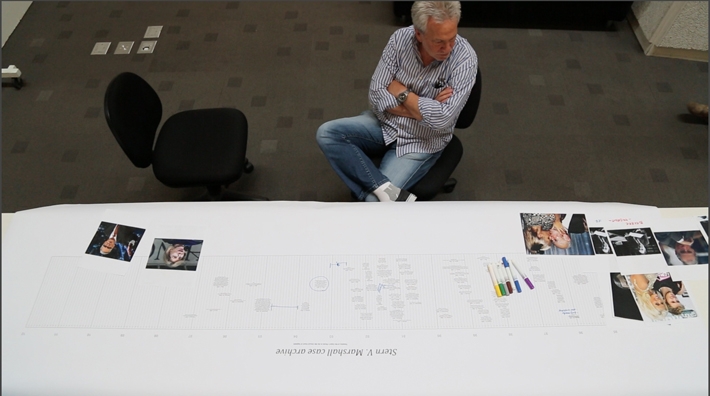
Staging an Interview
We invited Kent Richland, the appellate attorney who twice represented the estate of Anna Nicole at the Supreme Court, to an interview at ACCD in the morning. Over the course of the previous years, Kent Richland had shared the details of the trials, appeals, setbacks and triumphs with his son, sparking a certain fascination with the case. The case for Richland père marked a personal triumph, trying a case at the Supreme Court being a mark of distinction in US jurisprudence. Richland’s Los Angeles-based firm was to some extent an atypical advocate having a limited presence in Supreme Court cases compared to the attorneys for the Marshall family, thus displaying a fortuitous symmetry with the optics of the case that pitted a proto-typical Californian heroine (Anna Nicole) against the moneyed Eastern establishment of the Marshall heirs.
In preparing for this interview, we wanted to carefully think through the material conditions of the interview. In the classical ethnographic tradition, interviews are often unstructured or semi-structured, occurring in a carefully negotiated space and time to create the conditions necessary for an ideal response from their subjects. Whether this is achieved by positioning oneself in a context that is familiar and comfortable to the interlocutor (the domestic arena, worksite, or public space) or creating the conditions of comfort in an artificial space, ethnographers have long recognized that material conditions affect the response of subjects. Ethnographers are also trained to attend to non-linguistic facets of communication (body language, silence) and to their role in shaping the dialogue that emerges from an interview. A successful interview is one in which the interlocutor is at ease and expressive because the frame of the ‘interview’ no longer calls attention to itself and is being experienced as a simple exchange.
For our interview with Richland, we reversed this typical course by calling attention to the interview frame and heightening its formal qualities. This decision was intended to disrupt and overcome two specific conditions. Firstly, Richland and his father were overly familiar with each other and at times would leave commonly understood or shared ideas unstated. Secondly, they had told each other the story of the case many times before, both during the course of events as they unfolded and in retrospect when recounting the case history. We decided to utilize theatrical strategies by designing an interview ‘scene’ that marked the temporal and spatial parameters of this encounter and used video and audio recording to impose an obvious technological mediation. These elements were intended to provoke a kind of meta-text concerning the valuation of the case as a significant event worthy of study as well as the ways in which its interpretation was inflected by personal history and kin relations (Richland and Richland père).
We staged the interview around a table in a more open or public intersection in the Wind Tunnel, covered with a large-format timeline of the case history as a material prompt, with four cameras simultaneously recording the event. The graphic below shows the set-up of the cameras. A high-quality video recording was shot from above framed on the tabletop to document the gestures and the spatial relationships of the respondents. An additional camera focused from center balancing the two figures in frame, while two additional cameras from left and right each focused on the individual respondents respectively. A master audio track was recorded separately using a digital recording device on the tabletop for higher quality sound. By linking the time-code on all the videos, it is possible to compare from multiple angles the event as it in unfolded over the three hours of the interview. This strategy has a double purpose. It allows us to re-watch the interview at a temporal remove and to shuffle moments of significance without being subject to a centralized point-of-view. We see the recording as a dynamic framework through which to recall the interview data. This stands in contrast to the typical ethnographic practice of writing field notes that attempt both to recall and synthesize qualitative data. Field notes preserve what is recalled by the ethnographer usually directly after the encounter. A constant concern in fieldwork is writing things down while they are “still fresh” in the ethnographer’s mind. We suggest that this strategy be complemented by a full-engagement with the power of documentation that allows the synthesis of events to happen at a greater remove. Recordings can be seen here not as a pale imitation of the actual event, but as a way of reconstructing them outside the subjective frame of the ethnographic eye.

But equally important is the effect of the technological apparatus on what actually occurs. Even if the recordings are never re-watched, the mere act of recording creates a drama of heightened importance around the interview itself. As a performance, aesthetic concerns (about the quality and amount of lighting, the type of table around which the interview participants sit and their positions relative to one another, the objects they interact with) come into focus and can be used to reveal tacit understandings about what ‘matters’ in the discussion.
Our second device, a large-format timeline, served a similar purpose: to amplify the conversation by directing its course. The timeline is a standard graphical method to display data that charts incidents over time and could serve as a device to read the complex case history through a visual rendering. Working from a list of significant events in the case history pulled directly from http://www.factweb.net/timeline/, a website created by the attorneys for the Marshall estate, Cantarella organized the events chronologically using fixed columns for each year of the case. The result showed a pattern of clusters (years in which numerous rulings were made) and holes (years in which very little appeared to have happened). We printed the document on a large-scale (72” x 36”) so that it could cover the table-top where the interview was being staged. This would allow Kent Richland to walk back through the history of the case, commenting on the holes and clusters and guiding the interview process. It also allowed numerous markings, corrections, and notations on the paper creating an increasingly dense artifact of the day’s work. In fact, this document proved useful enough that we carried it over into the charrette process, where the design team could add their responses directly.
The timeline falls under the generalized category of a conversation object, a term that Elizabeth Chin has used to refer to a speculative object inserted into a ethnographic encounter to provoke response; there is a relationship to Grant Kester’s “conversation pieces” as an innovative art/activism form, although here it refers to discrete objects rather than large scale interventions designed to prompt dialogue among participants.[10] The conversation object can masquerade in many forms, a significant artifact, a schematic (like the timeline), or an aesthetic object created in response to a particular ethnographic question.[11] Our basic conversation object, the timeline, materialized a complex set of past events and invited debate and discussion during the interview as well as during the subsequent charrette.
The Design Charrette
A design charrette is a collective practice in which an assembled group of collaborators attempt to draft a series of solutions to a proposed problem. This methodology has become a standard strategy in a variety of design-based disciplines including theater making, urban planning, product design and software development, to name a few. Bringing together multiple constituents in the emergent phase of a design project makes it possible to capitalize on the divergent impulses and expertise of a group to generate a solution that no individual member has the capacity to propose on his or her own. The format capitalizes on rapid response, partial knowledge and productive misunderstanding. Individual members of the group are expected to engage without a comprehensive understanding of the goals or background of a particular project (as non-experts) and use the insights available to them to generate speculative solutions. Unlike a simple brainstorming session, the design charrette seeks to embody this knowledge in a variety of prototyped solutions developed rapidly and assessed by the group.
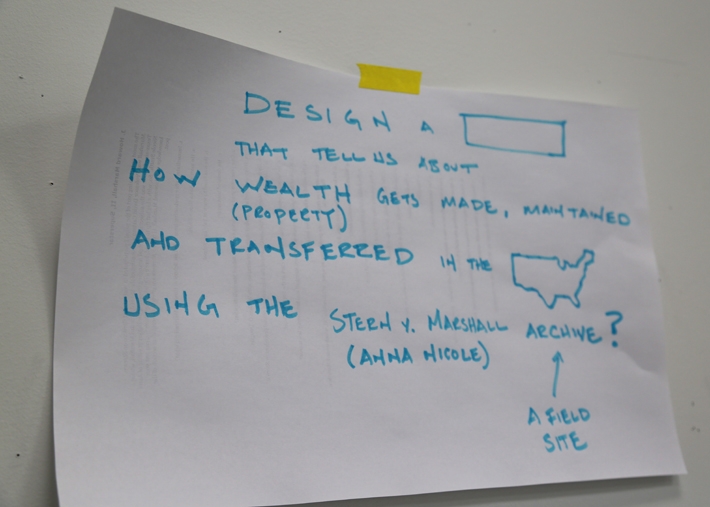
Applying the strategy to social conditions, the realm of ethnography provides both challenges and opportunities. Operating contrary to the normally individualistic design of ethnographic projects, the charrette allows us to make “public” the emergent phase of project development. While this occurs routinely during graduate study, in which projects are vetted by advisors and senior faculty, we see the development of charrettes being of particular interest to mid-career scholars engaging in second or later projects. Second projects by their nature often seek to extend the insights and expertise gained during initial research to new field sites or to extend them to related themes. More importantly, second and later projects in anthropology often challenge or require innovations in the emblematic culture of method which inaugurates careers.[12] Scholars who have established institutional bona fides are in need of strategies to deepen their research interests without simply recreating the conditions of the initial fieldwork. There are several modes of design charrette that can serve as a potential model including theatrical collaborations (as was operative, for instance, in our earlier 214 Sq. Ft. and Trade is Sublime ’second act’ collaborations), architectural commission, and product design. We will focus here on the latter since it served as the tacit model for our work in Pasadena.
Our design charrette approach most closely modeled that used in product design, as typified by the client-designer relationship in which the client provides a brief that prompts a design response. The brief seeks to encapsulate the goals of the project. In the context of a product this may entail both intangible notions of style and brand identity as well as practical instruction about deliverables, cost-basis and target audience. For example, a shoe company seeks to develop a new line of running apparel. They might present their in-house or contracted designers with an amorphous collection of inspirations for the product including both references to existing products made by their competition and other prompts only tangentially related to shoes themselves such as music, automobiles, fashion photography, and verbal descriptors. The design team then seeks to reflect back to the client not simply what they have asked for, but rather a better, more insightful materialization of their implicit desires. Therein lies the value added by the design process.
The setting of the Wind Tunnel gave us access to masters-level design students in the lab who could serve as designers for a client: Richland. As designers, they were accustomed to working in an information-poor mode, often expecting to produce design proposals based on very little information about what a client might want. We played an intermediary role facilitating this information-poor modality by asking Richland to present a brief about his project to the team. This is challenging for academics because we are accustomed to providing quite thorough material to our peers. Professionalism in our field is conveyed in part by performances through which we point to our rich data, theoretical framework, and the broader implications of our work. In turn, our peers weigh the significance and generalizability of our findings. Yet such completeness can foreclose or over-determine the design (and ongoing analytic) process. Moreover, placing Richland in a client position speaking across areas of expertise to designers forced both a translation process and a process of refining or prioritizing the set of ideas within his project. Cross-disciplinary collaboration is not uncommon among social scientists, and it is recognized that one of the values of collaboration is that it requires those involved to shed their disciplinary jargons. In our design workshop, Richland had to translate and also distill a sprawling set of materials and concerns related to the MSVA in order to instigate a design response.
This response came in the form of design speculation, a process often associated with architects or futurists. For our purposes, it simply meant asking the designer to propose materializations or interventions in response to ethnographic concerns. Richland began by presenting the design brief and then gave a condensed case history of his experience and suppositions about the project. In regards to our schema, we posited the case archive as a necessary subject, the starting point upon which the other two elements (design interface and interpretative community) could be imagined. Then, gathering around the large timeline that was now partially annotated with notes and images from the morning’s session with Kent Richland, the conversations progressed with the designers added additional notations and drawings. The speculation quickly focused on the use of storytelling devices. Charles Dicken’s novel Bleak House, the novel alluded to in Chief Justice Robert’s announcement of the opinion in Stern v. Marshall (SCOTUS, Case 010-0179), became a useful reference point. Published in a serialized form in 1852-3, the narrative centers on the case of Jarndyce v Jarndyce as it moves through the English Court of Chancery, and highlights the crisis the of the power of testators relative to the rule of law. The Victorian novel, dense in granular detail yet defined by an overarching thematic progression, seemed an appropriate corollary for the kind of narrative clarity we were seeking. In addition, we employed the large-scale timeline to help the group to visualize the three temporal zones that the case navigated: the possible future (imagined in the past at the creation of the will), the actual future (arrived at in the present) and the future future (posited as a consequence of court action).
Working from this incomplete understanding of the case and its implication while drawing from resources based on their disciplinary expertise, the designers were given the prompt to “Design a __________ that tells us about how wealth (property) is made, maintained and transferred in the United States using the Stern v. Marshall Archive” (see fig. 2). The four designers immediately began to conceive of possible devices, games, exercises and processes that could hypothetically be designed to materialize some or multiple facets of the prompt. The list, selections from which are detailed below, was extensive and ranged from the fantastical to the easily rendered. As a first stage in designing a productive encounter, these proposals remained largely theoretical, but one could easily imagine a more extensive charrette project in which actual prototypes could be assembled. In fact, Chin’s research facility at the Art Center, chock-a-block with making devices, is uniquely equipped to deal with that possibility. That said, even in a more resource poor studio environment, merely postulating ideas and deferring their articulation until later holds real value for the ethnographer. Addressed to a lesser degree was the identification of possible interpretative communities upon which to play out these ideas, although some of the suggested designs more easily implicate a particular community for engagement.
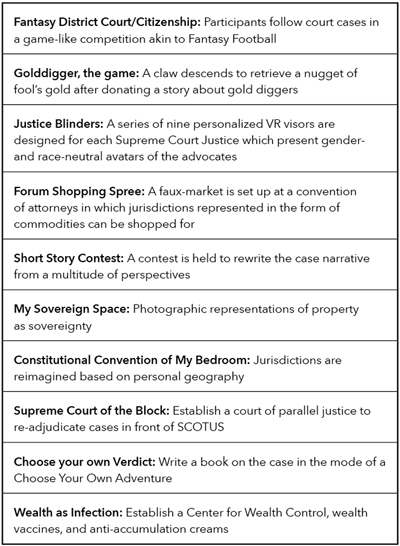
The staged interview and the design charrette were not ‘productive’ in the same way that more typical ethnographic methodologies are thought to be; there was no new ‘data’ collected that day. But they were both productive in the sense that they transported Richland to new vantage points, through acts of translation and visualization, from which to consider what he understood thus far about his subject. They also amplified certain aspects of the Archive that Richland had not been able to hear or see previously. By proposing an ‘as-if’ scenario, in which designers were asked to operate as-if they were developing ideas for a Productive Encounter that would be materialized and brought to fruition at some point in the future, the workshop set in motion collaborative interpretation and knowledge production, rather than the refinement of individual expertise, as a way forward in Richland’s project. Our working assumption was that the further development and implementation of one or more of the ideas generated during the workshop would enrich Richland’s ongoing investigation into the SVMA in ways outlined below.
Friday: Productivity
We offer the schema for Productive Encounters both as a tool for ethnography and as a mode of critique through which ethnographers and designers can construct a collaborative process. As a tool, it is best understood and assessed in terms of how it provides ethnographic methods that can address the specific problems of contemporary fieldwork identified, for example, in Faubion and Marcus (2009) such as the status of expert subjects and networked field sites.[13] As a mode of critique, its utilization lies in translating the dialects of social science into terms that design and art can respond to. These experiments could be simultaneously and somewhat differently produced through methods that come within the realm of contemporary art practice and its situated interventions. Jostling between ethnographic materials and design practices, such as we have described here, and related modes of situated contemporary art invention are on our future agenda. Here, we have chronicled the specific challenge, and methodological response, that was afforded us during our week in the Wind Tunnel, workshopping an emergent ethnographic project in a molten state, so to speak. It stimulated the formulation of the Productive Encounter model that we propose speculatively for the first time in this essay. Reflecting on our experiments in this modality prompts us to return to the question raised above: what makes the kinds of encounters we propose productive.
Ideally, a Productive Encounter clarifies and enriches solitary strategies of ethnographic research in progress through collaborative design modalities. These modalities a) encourage a self-assembling process that b) incentivizes and creates occasions for interlocutors to engage and c) amplifies thinking, ideas and insights among micro-publics and in relevant sites of inquiry, beyond those which might have been perceived or considered by the lone ethnographer cultivating subjects in the field. Productive Encounters thus generate unique, deeply felt articulations of contemporary problems that ethnographers have previously tried to gather and interpret in the classic fashion from their interviews, conversations, and observations.

These traditional methods have not provided a sufficient means to express and develop the research process as modes of thinking—collective, speculative, and creative—before conventional publication and professional assessment. For now, Productive Encounters as experiments in methodological practice remain alongside or in the background of ethnographic process, but they have the potential to play a more definitive role in the evolution of ethnography as a form of observation, analysis, and representation. Here we elaborate briefly on each of the features that have contributed to the modality of Productive Encounters at the intersection between design and ethnography, and that have been especially useful for us in our own recent history of collaboration.
Self-Assembly: Productive Encounters encourage an exploratory working process that is theoretically and materially responsive to emergent conditions and questions, and that seeks to seriously ‘play with’ an analytic trajectory, embedded in research practice, that may otherwise be overly abstract and deterministic.
One of the underlying logics of the Productive Encounter is assumption that the act of assembling, making or materializing something externalizes what are more typically internal analytic processes. Moreover, the making of these projects also provides a way to think through or reveal the process by they are made.
Using utility (a value championed in design discourse) as a guiding force, we seek a kind of self-assembling work that adopts an exploratory approach, in which an object, gesture or supposition is first made without a pre-defined theoretical framework; then in a dialogic process, the work reveals its own signifying systems. This responsive approach demands a lack of medium-specificity from the artist or designer (their responses can take almost any form). The only constant “medium” is the social phenomena itself, brought to the encounter by the ethnographer in some form, as data, notes or reflections on fieldwork in progress. Clear connections can be seen here to the rise of a complex array of time-based, social or relational aesthetic projects debated and assessed by scholars like Bishop (2012), Bourriaud (1998), and Kester (2004).[14] The Productive Encounter as a critique can be seen here as a corollary system that resolves issues of (social) scientific functionality and aesthetic robustness in hybrid design forms.
It may be useful here to think, in a strictly metaphoric sense, about the kind of relationship that is presumed to exist between an artist and the autonomous art object. For instance when a painter like Gerhard Richter suggests that his work instructs him, he creates a purposive schism between his intentionality and the product of his hand. Whether through an explicit process (chance procedures or otherwise) or simply the adoption of this stance, destabilizing the autonomy of the production of art has proved an effective strategy in the modernist tradition for moving past the limits of the investigator’s own governing systems (aesthetic or otherwise). For Productive Encounters, the materialization of ideas creates a useful schism between observation and written analysis because it inserts an intermediary process by which the ethnographer allows working or speculative knowledge to emerge through an encounter that is experimental, responsive and unpredictable.
Designing chance operations, as our design collaborators began to do with the Stern v. Marshall Archive, can help the ethnographer overcome the limitations of a habituated intellectual framework and develop new terms in which ethnographic data can be explicated. In Richland’s work, large, implicitly subjective frameworks of understanding threatened to constrain his ability to clarify a working sense of the ethnographic ‘real’. The iconographic power of Anna Nicole and J. Marshall Stern created make it difficult for him to tell the story in a satisfying manner, a problem Richland keenly anticipated at the start of his work on the project. For almost any researcher, the embedded framework of understanding (whether narrative, theoretical or aesthetic) limits the product. It is a box that one can not “think” oneself out of without collaborative help. The Productive Encounter process challenges the ethnographer to actively design a system that works around and trumps the limitations of individual reflection (ironically, this is the same license that the 1980s Writing Culture critique of objective realism in ethnographic writing thenceforward offered ethnographers) through the methods of collective understanding referenced above in the design charrette process.[15]
Incentivization: Productive Encounters use incentives and invent context-sensitive situations to materialize a micro-public or temporary interpretative community of variable composition to realize ethnographic ideas already active in planned or initiated field research. Engagement with an idea or subject is incentivized using design strategies like beauty, playfulness, utility, or exchange.
Productive Encounters incentivize a potential interpretative community to invest in or draw near the subject of the research. Incentivization is an idea often associated with marketing or behavioral science; we seek to reclaim it as an active strategy for engagement with interlocutors that pushes against the notion that anthropologists are unlike their interlocutors in their motivation to develop insights about the social world. The type and manner of incentive will vary widely depending on the design of the intervention and how a project is concretized. For example, was materialized in the form of multiple art mediums (film, dance/movement, architectural model, music), but its primary mode was not in concerned with or in service of the aesthetic regime of art.[16] Instead it merely used aesthetic tools to incentivize engagement. As such, formal beauty, indeterminacy (a provocation of curiosity through the combination of incongruous forms, such as using dance to convey multilateral trade, shifting perspective through the miniaturization of the WTO headquarters building in model form, or non-linguistic embodiments of institutional directives, etc.) and conditionality (drawing the audience near and inviting their active interpretation by framing the piece as a series of ‘proposals’) were declared values in the construction of the work. While the piece was not art, it masqueraded as art’s double.[17] Moreover, although artworks were of value (decorative or otherwise—it was not clear) to those in the upper echelons of the Secretariat (as evidenced by their commitment to art restoration projects and purchases for the WTO building), art itself was not directly related to the work of the institution. Nonetheless, art became an opportune site for public discourse, and a space to be occupied by our ethnographically-informed intervention. Art’s strength as a site of discourse was precisely in its weakness or irrelevance to the “real” work of the WTO. It became an ideal strategic place in which to situate ourselves in order to negotiate an engagement with the otherwise reluctant, indifferent or non comprehending informants who regularly passed through the halls of the building. This was in effect the production of a Productive Encounter as a second act of ethnography, stimulating engagement in a modality other than the vernaculars of economics, trade negotiation, bureaucracy, or diplomacy. These were the same values that were probed with variable success in the conventional ethnography that in this case preceded the ‘second act’ Productive Encounter.
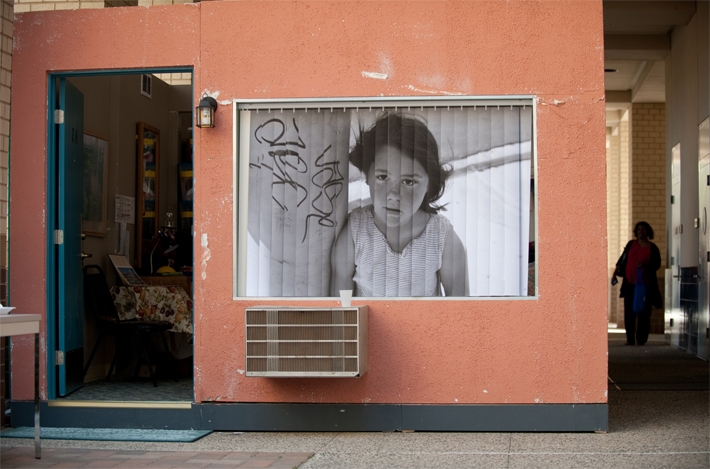
Our earlier project, 214 Sq. Ft., employed a different set of incentives in keeping with its designated manifestation as advocacy. Cantarella and Hegel were commissioned by a non-profit organization, Project Hope Alliance, to manifest the experience of homelessness for the organization’s gala benefit fundraiser. The project took the form of a mobile full-scale motel room designed to resemble the typical dwellings of the homeless families in Orange County, CA. 214 Sq. Ft. incentivized engagement by documenting the spatial reality of an at-risk population and provoking curiosity, and a sense of permitted trespass, for the donors. The model motel room was a private space filled with the artifacts of family life in which one could, for instance, peek into cupboards and closets, glance through family photo albums and open the medicine chest; at the same time, objects in the space (a clock radio, a drawer, the heating vent, etc.) resonated with the voices of our audience through hidden audio and video elements that could only be overheard or glimpsed when drawing near the object. The hundreds of people who have toured 214 Sq. Ft. were explicitly invited to do so by event organizers; at the same time their journey through the space, their desire to look and touch and overhear, and in turn to reflect upon and discuss with other visitors, was provoked by design elements that engage them sensorially and emotionally.
Thus, Productive Encounters may deploy beauty, curiosity, play, problem-solving, reward, respite, excitement, insult/shock/counter-normative suggestion, knowledge, foodstuffs, currency or any other feasible incentive within the framework of their operation that has value within their interpretative community. Their efficacy (or productivity) can be measured in the aptness of each Encounter’s particular design utilization of a priori available space for engagement within the conceived and incentivized interpretative community. The design workshop for the Stern v. Marshall Archive, the other variation on the Productive Encounter modality that we have have focused on in this essay, worked purely in the speculative realm to examine and re-configure the conceptualization of fieldwork yet to be done.
Reluctant informants are a common problem faced by ethnographers that the Productive Encounter seeks to reconceptualize in practical and specific ways. Most ethnographic projects face certain barriers in engaging subjects in meaningful and revelatory discourse. Reluctance may stem from issues of trust, language, class difference or simply the inability to express tacit knowledge. To overcome these obstacles anthropologists expect immersion (depth and duration are key evaluative criteria of ethnographic research) and mimicry (adopting the stance and argot of the native) of its practitioners. Both strategies rely on a brilliant individual fieldworker who can employ the techniques with skill and subtlety. A designed intervention, modeled here as a Productive Encounter, is a mediating apparatus and process that illuminates how ethnographic knowledge is collaboratively produced and not simply discovered and collected.
Amplification: Productive Encounters can amplify the more intimate and privately developed knowledge muted in the immersive and solitary frame of traditional ethnographic encounters, and can turn the volume up on tacit knowledge.
Design practices amplify the hunches and suppositions of research-in-progress by testing out different compositions of developed materials and imagined micro-publics. In the Stern v. Marshall Archive workshop, in which we sought to develop ideas for a future Productive Encounter, we began to see this kind of amplification. It was activated in part through processes of translation as Richland spoke across the divide of expertise to designers unfamiliar with the concerns of legal anthropology, the specifics of bankruptcy law, and the complex history of the parties to the cases. Collaboration turns the volume up on what we understand to be true about something, or relevant, so that our collaborators can hear and contribute to its analysis; this is especially true when we build in the hurdle of working with collaborators who share neither our typical working practices nor our ways of thinking.
Amplification is also a useful way to understand the kind of operation a Productive Encounter might perform in lieu of, or alongside, traditional ethnography. We’ve noted above the way that ethnographers accrue data through a kind of embedded, durational practice that is intended to erase the experiential and communicative gap between the ethnographer and her interlocutors and in so doing lay bare tacit knowledge otherwise unavailable to outsiders. Yet, we propose, there may be other routes towards tacit knowledge. The installation sought to provoke an exchange by amplifying issues of contention beneath the surface at the WTO, which we made manifest in the work. By materializing (through abstract films) facets of the organization’s guiding principles (Allow trade to flow more freely, Everyone must follow the same rules, etc.) our aim was to elicit agreement or denial that these principles reflected a version of reality. offered an alternate discourse of engagement that allowed interlocutors to re-frame their tacit understanding of institutional culture at the WTO within the relatively level-playing field of aesthetics; something they had no requirement to be expert in, but had the right to comment on. This encounter utilized powerful open signifiers, in response to which informants were encouraged to construct meanings, as a mechanism to raise the volume on unspoken concerns about the future of the organization and the use value of a multilateral trade regime more broadly. When implemented as a ‘second-act’ intervention, as Marcus sought to stage at the WTO, the follow up deepens insights from the original fieldwork and can address the failures or limits of an immersive ethnographic method.[18]
In a similar vein, our 214 Sq. Ft. installation was designed to amplify the lived experience of chronically homeless families through a fictional representation in three-dimensional form. It was a ‘realistic’ representation in that it was based on images and documentary footage of, as well as visits to, families in temporary motel housing. At the same time, it amplified that circumstance by taking varied examples and layering them together in the installation, and by making the furniture, the walls, and various objects ‘speak’ their plight. This in turn prompted visitors to encounter that phenomenon in a saturated way that had the effect of prompting many to express strong sentiments and beliefs about poverty, charity, homelessness in Orange County, morality, and other issues. For example, when the installation was relocated to the grounds of Pastor Rick Warren’s Saddleback Church the piece amplified Christian fundamentalist morality tales within the context of the imploding Southern California real estate market of the first Obama administration. The installation continues to travel throughout California and the United States as a vehicle for Project Hope Alliance to raise awareness and funding, and each locale offers an opportunity to provoke varied interpretative communities to make explicit what otherwise might have remained tacit and internal.
In conclusion, our aim here has been to elucidate a model of ethnographic work that draws on design modalities and to convey the potential value of this type of intervention. We posit that Productive Encounters are one kind of solution to the challenges of knowledge production for anthropologists. Design modalities disrupt typical ethnographic trajectories by repositioning experts into non-expert zones of discourse, creating chance operations and false constraints, opportunities for useful failure, and other operations that we consider productive for the overarching aim of deepening anthropological insight. However composed, such encounters have the potential to generate hybrid, deeply felt, embedded, and original articulations of ‘contemporary problems’ (the object of ethnographic work everywhere) not readily available through other forms.
Luke Cantarella is an associate professor of design at Pace University. He has designed over one hundred productions including work for the theater, opera, dance, film, television and commercial design. Theaters he has worked at include the Atlantic Theater Company, American Repertory Theater, Pittsburgh Public Theater, Yale Rep, Prince Music Theater, Northlight Theater, Repertory Theater of St. Louis, Rozentheater (Amsterdam), Lyric Theater of Oklahoma, Berkshire Theater Festival, Barrington Stage Company, Adirondack Theater Festival, CITY Theater, Synapse Productions, New World Stages, and many others. He has designed operas for Wolftrap, Curtis, Peabody and the New England Conservatory of Music. Luke’s creative work often extends beyond the theater. Recent projects include 214 Sq. Ft., a meta-site for anthropology relating to the motel families of Orange County developed with Christine Hegel, the Center of Ethnography at UCIrvine, and Project Hope Alliance. He also co-created the installation The Flocktree with Jason Cantarella, a mathematician specializing in knot theory, supported by Ideas for Creative Exploration in Athens, Georgia. His paper Originality, Autonomy & Control was presented at the Prague Quadrennial 2011 as part of the IFTR Scenography Working Group. Luke received his M.F.A. from the Yale School of Drama in 2000. He completed his undergraduate work at Northwestern University, where he earned a B.S. in Speech in 1994.
Christine Hegel is Assistant Professor of Anthropology at Western Connecticut State University. She received her Ph.D. from CUNY Graduate Center and was affiliated with the Institute for Money, Technology, and Financial Inclusion (IMTFI) at UC Irvine. Her work has been focused on questions of contemporary legal subjectivity in the Middle East, which she examined through ethnographic research on contracting, litigation, and documentary regimes in Egypt. This research has formed the basis of essays in Anthropology of the Middle East and North Africa Into the New Millennium (Indiana University Press), Family Law in the Muslim World (I.B. Tauris) and Law, Culture, and Humanities Journal. Since 2011, Hegel has been collaborating with George E. Marcus and Luke Cantarella on projects that explore intersections between design and ethnography. They have co-designed installation pieces 214 Sq. Ft. and Trade is Sublime and currently are preparing a book manuscript on design modalities for ethnographic inquiry.
George E. Marcus is Chancellor’s Professor in the Department of Anthropology at the University of California, Irvine, since 2005—where he helped found the Center for Ethnography—and previously served as Joseph D. Jamail Professor (2001–2006) and chair (1980–2005) in the Department of Anthropology at Rice University, where he taught from 1975 to 2006. Marcus served as the founding editor of Cultural Anthropology, Journal of the Society for Cultural Anthropology. His text Writing Culture: The Poetics and Politics of Ethnography (coedited with James Clifford, 1986) is considered one of the most influential works of contemporary anthropology, marking a shift in its diversity and range of research styles. In the same year, he published Anthropology as Cultural Critique: An Experimental Moment in the Human Sciences (with Michael M. J. Fischer). He later published a retrospective collection of essays on ethnography, Ethnography Through Thick and Thin (1998), which included a number of provocations—multisited ethnography, ethnographic complicity, and reflexivity—that would further guide anthropology into the next millennium. Marcus’s more recent research has focused on the ethnography of institutions of global power, and how they reach into ordinary, everyday, diverse lives. He has also begun to explore in a sustained way changes in anthropology’s signature method and how it might be influenced by experiments in collaboration with designers, artists, and visual media makers. Recent volumes include Designs for an Anthropology of the Contemporary (with Paul Rabinow and others), and Fieldwork Is Not What It Used To Be (co-edited with James Faubion).
Notes
[1] See, for example, Paul Rabinow and George E. Marcus, Designs for an Anthropology of the Contemporary (Durham: Duke University Press, 2008).
[2] Design Anthropology: Theory and Practice, edited by Wendy Gunn, Ton Otto and Rachel Charlotte Smith (London: Bloomsbury Press, 2013).
[3] In Richland’s case, this was a key challenge. How to describe the value of specifically ethnographic analysis for a legal discourse that was already subject to an expert legal analysis? See Dominic Boyer, “Thinking Through the Anthropology of Experts,” Anthropology In Action, vol. 15, no. 2 (2008), pp.38-46.
[4] Between 2008 and 2010, an international team of ten anthropologists conducted ethnographic research on various aspects of the operations of the WTO Secretariat at the CWR in Geneva. The 2008-2010 interval was a dramatic period of world economic challenge, and at the WTO especially, a frustrating period of failure to complete the longstanding (since 2001) Doha Round of global trade agreement among its 159 member nations. The results of these research projects were published as an edited volume, Des Anthropologues á l’OMC, edited by Marc Abélès (Paris: CNRS Press, 2011).
[5] For a chronicle of this second act project, see George E. Marcus, “A Chronicle of an Intervention at the World Trade Organization in Five Not So Easy Pieces” (2014, submitted to FIELD).
[6] See www.tradeissublime.org. Luke Cantarella and Christine Hegel, “Trade is Sublime: Rethinking the Field through Multi-modality, Visual Metaphor, and Circulation,” presented at The (Troubled) Field Conference, New School for Social Research, April 26, 2014.
[7] Justin Richland, Arguing With Tradition: The Language of Law in Hopi Tribal Court (Chicago: University of Chicago Press, 2008).
[8] Tim Ingold, Making: Anthropology, Archaeology, Art and Architecture (London: Routledge, 2013).
[9] Keith M. Murphy and George E. Marcus, “Epilogue: Ethnography and Design, Ethnography in Design . . . Ethnography by Design,” in Design Anthropology: Theory and Practice, edited by Wendy Gunn, Ton Otto, and Rachel Charlotte Smith (London: Bloomsbury Press, 2013), pp. 25‑68.
[10] Grant Kester, Conversation Pieces: Community and Communication in Modern Art (Berkeley: University of California Press, 2004).
[11] A useful example of the conversation object from Chin’s studio can be seen in the work of Barb Natali. In the course of her work at the studio’s fieldsite in Kampala, Uganda, Natali became interested in the discourse surrounding the control of the female body specifically in response to a new set of modesty laws introduced in the Ugandan legislature in 2011, popularly known as the “anti-mini-skirt law”. Natali crafted a response in the form of a speculative object: a pair of shorts wrapped in barbed wire, which she proposed selling in the Owino market, the large marketplace in central Kampala. Created with local tailors, the prototype was then used to provoke conversations centering on the female body and sexual violence. This ingenious materialization of a social condition provided a means of exposing tacit knowledge and generating new engagements with a complex theme. For more on this project, see http://barbaranatali.com/#thesis.
[12] George E. Marcus, Ethnography Through Thick & Thin (Princeton: Princeton University Press, 1998).
[13] James Faubion and George E. Marcus, Fieldwork Is Not What It Used To Be (Ithaca: Cornell University Press, 2009).
[14] Claire Bishop, Artificial Hells: Participatory Art and the Politics of Spectatorship (New York: Verso, 2012), Nicholas Bourriaud, Relational Aesthetics (France: Les Presse Du Reel, 1998) and Kester, Conversation Pieces (op. cit.)
[15] It should be noted that strategies in art production have a robust history of exploring methods of subverting the limits of individual subjectivity. The so-called “Wrecking” projects of choreographer Susan Rethorst are a good example. She invites artists into her rehearsals mid-way through the development of a dance to “wreck” the work. The choreographer or director takes over the rehearsal and begin to re-make the dance based upon his or her own concerns without complete disregard for Rethorst’s a priori intentions. Rethorst developed this strategy in response to her long-standing concern about the tyranny of control. In her pedagogy, she identified a primary artistic challenge not in, as is commonly asserted, finding one’s true voice, but conversely in silencing the dominance of that voice. She writes, “the self is a constraint from which there is no escape, that unique inner world which never quits.” Susan Rethorst, “Stealing, Influence and Identity,” in Movement Research Journal, no. 21 (2000).
[16] Jacques Rancière, Aesthetics and Its Discontents (London: Polity Press, 2007).
[17] See Marcus, 2014, op. cit.
[18] Additionally, important secondary effects are created around the site of the research. Jae Chung, a member of the original CNRS-funded WTO research team, adviser and interlocutor in the creation of Trade is Sublime, joined us at the CWR for the two-week exhibition of the piece. She found that our intervention and presence created an atmosphere of heightened dialogue in her interview-based process, that continued throughout the period of installation. Chung’s research during a return trip to the WTO was markedly enhanced in its own trajectory by the context and presence of our parallel ‘second act’ project.

